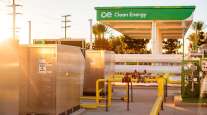Managing Editor, Features and Multimedia
Producers Cite Positive Shift in Outlook for NatGas
ARLINGTON, Va. — The use of natural gas as a transportation fuel is increasing in an “era of unconventional” fuel sources, executives of several energy producers said at ATA’s Summit on Natural Gas in Trucking on Thursday.
There are abundant unconventional resources of natural gas with more than a dozen areas of shale gas that are active and becoming active, including the Bakken, Eagle Ford and Marcellus shales, said Richard Germain, manager of technology ventures at ConocoPhillips.
Germain described a “paradigm shift” in natural-gas exploration and extraction that has dramatically altered the outlook on the fuel. Back in 2005, the conventional wisdom was that natural-gas prices would remain high and supply was becoming more limited, he said.
But drillers are now tapping into “source rock” through the use of hydraulic fracturing - or "fracking" - and horizontal drilling techniques, he said.
“In just 10 years, we’ve gone from thinking that the natural-gas supply was in irreversible decline and we would need to be importing vast amounts of [liquefied natural gas] . . . to the point where we now think we have up to 100 years of domestic supply of gas,” Germain said.
In 2000, almost zero natural gas came from “unconventional” reservoirs, which now produce more than 30% of the industry’s supply and are expected to produce 60% by 2030, he said.
Germain also announced that ConocoPhillips has begun a new business effort to create localized supplies of natural gas.
“We’ve got our eyes on several major trucking markets, and I’m happy to announce we’ve begun development on our first project [near] Dallas,” he said. “We’re ready to build when we have the confidence the fuel is needed.”
This LNG facility will initially produce about 30 million gallons per year and can be operational within two years, Germain said, but demand will determine when the plant opens.
Ronald Jibson, chairman and CEO of Questar Corp., Salt Lake City, said the United States has lagged behind much of the world in the adoption of natural-gas vehicles.
Worldwide, there are more than 15 million on the road, but only about 137,000 of them are in the United States., he said.
“We’ve got a lot of room to grow,” said Jibson, who is also the incoming chairman of the American Gas Association.
That picture will change, however, because of equipment and engine manufacturers’ initiatives, advances in technology and an increasing emphasis on clean air and taking advantage of the domestic energy supply, he added.
“I know we’re going to start to see that needle move, and nowhere is there a greater savings than there is in the large trucking industry,” he said.




